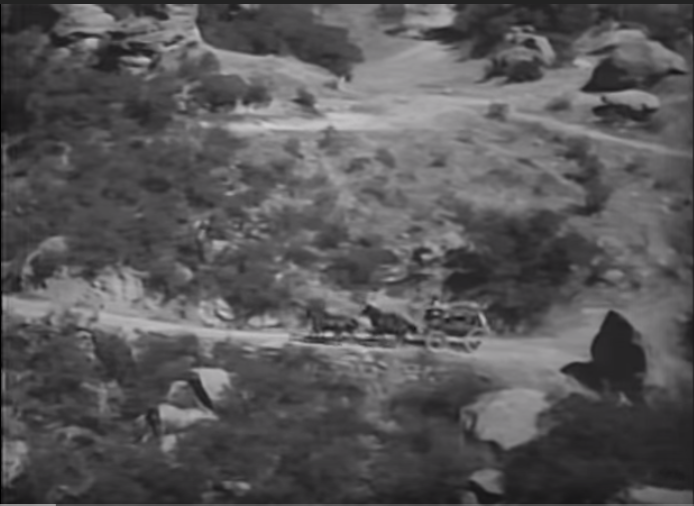What I watched: The twelfth episode of the first season of The Lone Ranger, a kid-oriented Western created by George W. Trendle. This episode starred Clayton Moore as the titular hero and Jay Silverheels as Tonto, with guest appearances by John Kellogg (not the cereal man), Robert Emmett Keane, Steve Clark and John Daheim.. This episode was directed by George Archainbaud and written by Gibson Fox and Doris Schroeder.. “Return of the Convict” aired on Thursday, December 1, 1949 at 7:30 PM on ABC, and is available to watch on YouTube.
What happened: The Lone Ranger tells Tonto about John Ames (Kellogg), a man who’s just been released from prison and is swearing to “get even” with two men who’ve wronged him in the past. The Ranger and Tonto track down the stagecoach in which he’s riding, and spot him with a gun. When he gets into the town with the curious name of Alkali Den, and the town sheriff (Clark) immediately tells him to move away like his wife and child did. Ames swears that he didn’t have anything to do with the robbery he went to prison for, and that his mission is to make the men who set him up pay.
The Ranger and Tonto go to the home of the Gunder brothers, the men who testified against him. They find no sign of the brothers, but spot blood, a hat with a bullet hole in it, and Ames riding away very fast. Tonto rides off to town, as he does approximately nine times every episode, and the Ranger spots a trail.

Back in town, the sheriff arrests Ames, having been filled in by that snitch Tonto. An angry posse has already gathered outside, lead by a man named Sim (Keane) and the sheriff quickly takes his captive out the back. The mob gets so angry they start throwing rocks at the sheriff, and quickly descend into mass brawling. The Ranger and Tonto come in to restore order.
Our hero supposes that someone else has murdered the Gunders and stirred up the lynch mob to pin the crime on Ames. Sim comes in and orders the sheriff to arrest the Ranger as an accomplice to the crime, and he goes on and does it. Fortunately, our outlaw hero is able to make an escape by clumsily wrestling the villain.
The Ranger and Tonto go out to investigate the ravine the brothers’ bodies were supposedly found in. They find the bodies, very much alive. The Ranger holds the Gunders (at least one of whom is played by Daheim) at gunpoint, and acts like he’s about to shoot them. He fires in the air, and they flee.
Back in town, the mob leader Simm tells the sheriff that he’s fired and is putting together a posse to hunt Ames and the Ranger. Of course, he’s in cahoots with the brothers, and they’ve been spooked enough to come to meet him. They verbalize their whole history of crimes while the sheriff sits outside the window. The brothers turn on Simm by slapping him around a lot, then the Ranger comes in to punch everybody out. And with that, justice has been restored!
What I thought: Once again, The Lone Ranger deals with its almost obsessive themes of the law and mistaken identity. Once again, we have a character who is being framed for another’s crime, and again we see the Ranger in an investigatory role, helping to expose the true evildoer to a friendly law enforcement official.
And yet there is a bit of uneasiness in this particular iteration of the plot. The inciting incident is a failure of state justice: the wrongful imprisonment of John Ames. The sheriff, while still portrayed mostly positively, is shown to be easily influenced by the crowd. The episode even portrays the tough-on-crime mentality represented by the lynch mob as an obstacle to justice and not a means to it. Okay, it’s not exactly Rectify but it’s an interesting idea to put forward on a kid’s show.

Of course, this only goes so far, which is not very far at all. Even though the legal system has given us no reason to trust it, the Ranger still hands over the real bad guys to the sheriff at the end. (We at least get an actual action scene at the climax this time, even if it’s not a long or interesting one.) In the end, the blame lies at the feet of specific individuals engaged in a conspiracy, not any kind of institutional failure.
This tension is indicative of American popular culture. Television as a whole is full of heroic police and prosecutors, with the police procedural being the dominant dramatic genre for at least two decades. At the same time, American media is full of stories about wrongly-accused men, heroic outlaws, and rebels who may or may not have the cause. The rule of law, it would seem, is best used to keep everyone else in line — you yourself have good reasons for your rebellion.
The plot point of mistaken identity is also one which the series has already returned to over and over again. This is characteristic of superhero stories, which The Lone Ranger is essentially a predecessor to. There must be a dozen stories in the early years of Marvel alone where some villain impersonates the heroes and ruins their good name. This series hasn’t used that particular plot yet, although I would bet on it occurring somewhere in the remaining 250 (yikes) episodes.
But even the repeated plots of other people being wrongly accused reflect an anxiety of the masked-vigilante genre — that the good guy’s actions are not that easily distinguishable from the villainy of the bad guys. This is the anxiety that also pushes the antagonists towards being mustache-twirling caricatures. Ironically, it is this insecurity about identity that makes the genre so distinctive.
Coming up next: A different kind of kid’s show, withKukla, Fran and Ollie.
